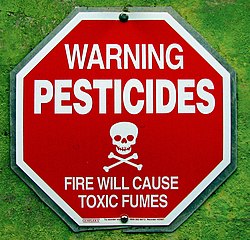Pesticide
A pesticide is a chemical that is used to kill or prevent small animals (or organisms) which are considered to be unwanted. These organisms are called pests. Some of these pests that people do not want are insects, microbes that destroy plants, and other things that affect humans in a bad way and it may kill humans too. Many pesticides are poisonous, and are bad for not only the organisms they kill, but for humans too. A pesticide also affects the environment and the atmosphere.
The Stockholm Convention on Persistent Organic Pollutants lists chemicals that are very hard to destroy, or very toxic. In total, twelve chemicals are listed. Nine of them can be used as pesticides.[1][2]
Types of Pesticides
There are different types of pesticides for getting rid of different pests.
- Herbicides kill weeds
- Insecticides kill insects that eat plants and crops
- Fungicides kill any bad fungi
Effects of pesticides
Pesticides are used to kill pests, but many are bad for human health. They may pollute water, and go into rivers, lakes, and ponds. This will cause acid rain, and organisms living in the water can get sick and die, because the water where they live has more acid.
Pesticides used to protect crops are very damaging to the general ecosystem. They kill not just pests but vital insects which do pollination and other things. Every area needs a balance, but generally we do not have a system which does this.
Alternatives
In many cases, there are alternatives to the use of (chemical) pesticides. These include:
- Use of genetic engineering
- Release of other organisms to control the pests, such as predators or parasites. That way, ducks can be used in rice fields to act against snails, for example
- Some foods can be processed and used to control certain pest
- Use of polycultures, that is growing many different crops together, rather than just one crop.
Pesticide Media
The cholinergic synapse and the breakdown of acetylcholine into choline and acetate by acetylcholinesterase
Preparation for an application of hazardous herbicide in the US
References
- ↑ "Stockholm Convention - Home page". www.pops.int.
- ↑ Gilden RC, Huffling K, Sattler B (January 2010). "Pesticides and health risks". J Obstet Gynecol Neonatal Nurs. 39 (1): 103–10. doi:10.1111/j.1552-6909.2009.01092.x. PMID 20409108.
{{cite journal}}: CS1 maint: multiple names: authors list (link)






